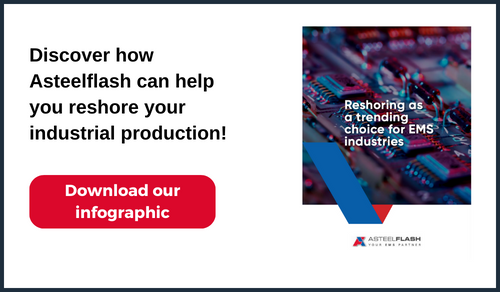Having seen turnover and profits dented by the effects of the COVID pandemic, many manufacturing companies are looking for ways to protect their supply chain from similar disruption in the future. One popular option, particularly for those who use electronic subassemblies in their products is reshoring – moving the production of those subassemblies from distant overseas locations, typically in the Far East, to locations much closer to where the end product will be sold. But how does this work in practice?
As an example, let us consider a company that makes a high-volume product that is primarily sold in Europe. The product incorporates a complex printed circuit board assembly (PCBA) that is mounted within a moulded plastic housing. The PCBAs are produced in China, the housings in Europe. The PCBAs are shipped to Europe where final assembly and testing of the finished product is carried out. What benefits could this company expect if it were to work with Asteelflash to reshore the production of the PCBAs?
Minimising supply shortages
First would be improved security of supply. Even if global disruption on the scale of COVID were to occur again, this would be much less likely to disrupt Asteelflash’s delivery of the PCBAs within Europe than the deliveries from China. A second benefit would be greatly improved responsiveness. Should the company require any design changes, Asteelflash would be able to deliver PCBAs to the new specification on a very short timescale – hours or days, in most cases. This contrasts to many weeks needed to ship updated PCBAs from China.
Smoother and more efficient product development is a less obvious but equally important benefit. Drawing on its extensive experience and its virtually unparalleled electronics manufacturing knowhow, Asteelflash works closely with its customers to help them optimise their designs, not only to deliver the best possible performance, but also to minimise manufacturing costs. While this collaboration can take place through remote contacts, face-to-face meetings and discussions are often more convenient and more effective.
Of course, the company may be concerned that moving the manufacture of its PCBAs from China to Europe will increase costs, as Europe is a higher wage economy. In reality the increase is small. Around 80% of the cost of a typical PCBA is components and materials, and these cost much the same in Europe as they do in China. Labour makes only a modest contribution to overall costs and, even then, any differences between Chinese and European rates will be offset by the very high level of automation used in Asteelflash plants.
Total cost of ownership of electronic subassemblies
In assessing the total cost of ownership of the PCBAs, it’s also necessary to take into account the reduction in shipping costs, the elimination of duties and currency exchange losses and the lower failure rate that can be expected from locally produced PCBAs. On balance, the cost difference can be expected to be minimal.
Should this customer reshore the production of its PCBAs? Asteelflash would recommend that they should , but with a proviso: it would be a good idea for a small amount of production to remain in China to serve the local market there and also to provide an added layer of resilience should it be Europe that suffers disruption at some time in the future.



